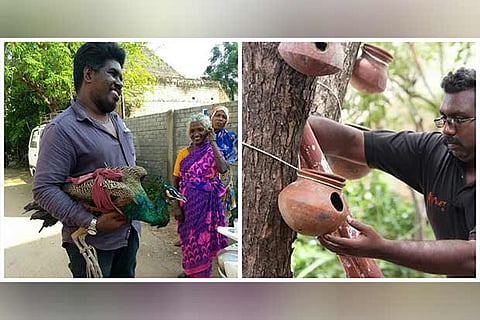

Thiruchirapalli
Even as parts of Tamil Nadu are facing drought-like conditions despite a bountiful monsoon in some other regions, it has emerged that cyclone Gaja that devastated the Delta districts last month destroyed not only horticulture crops, but also dealt a big blow to livestock population across the central districts.
For farmers, already finding it difficult to sustain their livelihood in the wake of the devastation, the cattle population has become a major worry as the availability of fodder has dipped drastically. It has forced the farmers to purchase the fodder at exorbitant prices, following which they have appealed to the state government to oversee measures to revive the cattle population in the region.
Though the government has been making a big effort to help the affected people recover in the aftermath of the cyclone, the revival of the cattle population is expected to pose a major challenge as the officials need to verify the death of the cattle with appropriate post-mortem certificates.
Official sources said the Animal Husbandry department of the respective districts have collected these reports and sent them to the Commissionerate of Revenue Administration (CRA) three days back and are awaiting its decision.
“Mostly, the priceless milch cow and goat scheme would be diverted initially to compensate for the cattle loss in the Gaja-affected regions,” a senior official said.
Among the devastated districts, Nagapattinam is the worst hit with more than 25,000 cattle lost. In Tiruvarur district, around 2,000 cattle perished, while in Thanjavur and Pudukkottai, it was 1,800 and 900 respectively.
Meanwhile, all cattle feed that had been stored was destroyed during the cyclone, in addition to significant loss of trees and crops, resulting in unavailability of green fodder. This has forced some farmers to sell their cattle to abattoirs to sustain their livelihood. The officials, however, managed to ensure that a proposal to distribute green and dry fodder to the farmers from these regions was sent.
Birds too need helping hand
After ‘Gaja’ made landfall in the Delta region, it uprooted several lakhs of trees in which thousands of birds died. At least 50,000 button quails (kaadai) perished in the region while hens, peacocks, cranes, crows and sparrows died either due to tree or wind damage. Since birds like crows and sparrows used to build nests in peepul or banyan trees and rest there, after the trees fell, a huge number of such birds were estimated to have died.
“If we assume that each tree sheltered at least five crows and sparrows, the loss would be more than 60 lakh birds across the Delta as it was estimated that around 12 lakh trees were destroyed in the region. Birds apart, several lakhs of eggs were destroyed as almost all the nests were damaged,” said R Sathish Kumar, trustee of Endangered Wildlife Environment Trust.
To revive the avian population, environmentalists have fixed artificial nests across the region. “It would be difficult to get the birds accustomed to these nests, yet there are positive signs as some have started to rest in these places. We have set up the nests in shady areas,” Sathish Kumar said.
Visit news.dtnext.in to explore our interactive epaper!
Download the DT Next app for more exciting features!
Click here for iOS
Click here for Android